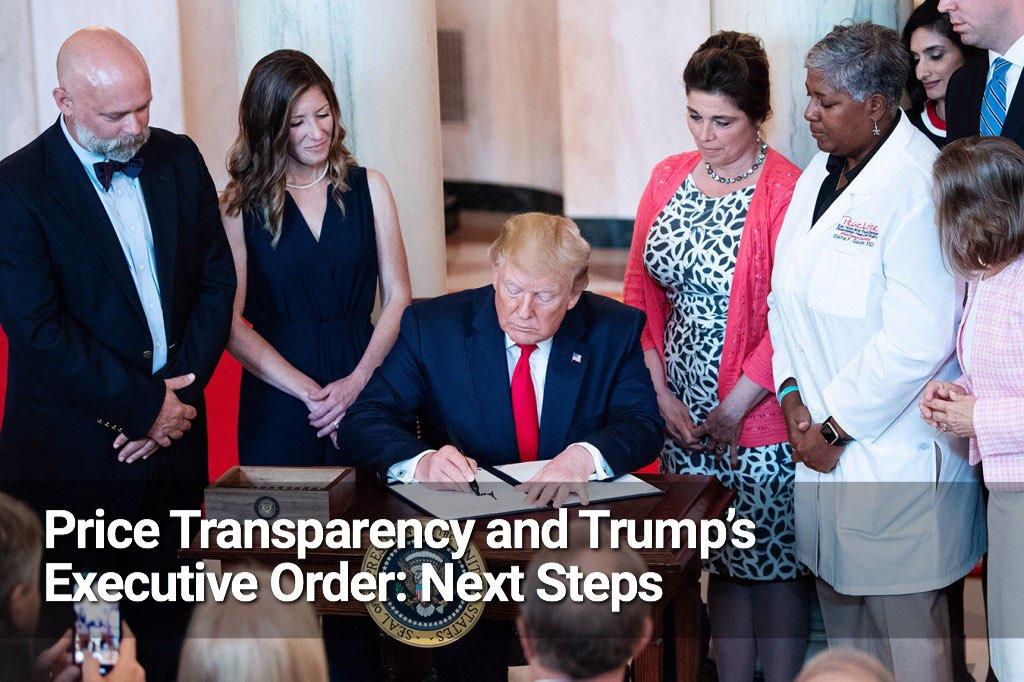Can Hospitals Get Ahead of Trump’s Executive Order on Price Transparency?

President Trump announced a new executive order last week and the implications will impact hospitals (providers) across the country. The announcement marks meaningful progress beyond the HHS rule from earlier this year that simply required providers to post retail chargemaster prices to their websites. However, it’s only a first step. Meaningful and clear rulemaking from HHS on what the order means in practice will determine whether patients truly get what they need to make a financially informed health care decision.
I’m an optimist at heart so the prospect of putting better more actionable information in patients’ hands is a step in the right direction. I’ve spent the past 15 years of my life building a market-leading healthcare revenue cycle software company and I understand how complex it is to provide patients with an accurate estimate of their actual financial responsibility. However, our employees at AccuReg developed a software solution that successfully achieves the goal of this executive order – providing patients with a self-service online calculation tool that provides accurate cost estimates on the front end.

“What is the Right Solution for Price Transparency?”
It took us 10 years of testing, refinement and development to be comfortable deploying this tool directly to patients, and by pure coincidence, we announced its launch on the same day President Trump announced the executive order. This innovative new product, Estimate My Cost® provides patients the same powerful and accurate price estimation tool that is used by our hospital clients across the country.
So, what will be required by hospitals to successfully achieve what the executive order intends? Let me provide some important context. I’ll start with four critical concepts:
- It is important we keep the patient/consumer at the center of any price transparency solution.
- Price Transparency and Cost Transparency are very different things.
- Negotiated prices are not Cost Estimates.
- Insured consumers and uninsured consumers are in very different financial situations, each requiring their own cost transparency solution.
Cost Transparency for Insured Patients
Since Trump’s order focuses on “negotiated rates”, let’s start with a scenario in which the patient has insurance. Hospitals and physicians contract with dozens, and sometimes hundreds, of health insurance entities, including commercial insurance companies, the government, and often directly with self-insured large companies. If a provider has 20 payer contracts, it could have 20 different negotiated rates – for each procedure. This will be a major challenge for HHS to aggregate – will they require hospitals to publish rates from all 20 (or 100+) payers for each “shoppable” procedure? Sure, a savvy consumer could feasibly search for a procedure and a payer within in a grid (or a searchable app) and find the negotiated price, but that’s just for one facility. More importantly, for insured consumers, the negotiated price does not represent what the patient will owe; the “out of pocket” (OOP) balance after insurance (“BAI”) – after their insurance has paid their part. Providing the OOP balance for a procedure that is payer-specific and hospital-specific in such a way that the patient can compare between providers will be more of a challenge for HHS than any resistance from the industry to reveal competitive price lists. I am all for price transparency reducing the cost of care, however we cannot lose sight of what patients want; OOP cost estimates that reflect BAI, which is not the same as the rate the payer and provider negotiated. I hope HHS will not waste a lot of time trying to force providers and payers to post negotiated rates that, like retail chargemaster rates, are irrelevant to patients. A more productive course would be to develop national requirements, standards and processes for patient cost estimations.
Verification before Estimation
Before a provider or payer can calculate a patient’s OOP cost estimate, they must first verify the patient’s demographics, eligibility, network, benefits, coverage limitations and pre-payment requirements. For an insured patient looking to estimate their cost prior to service, after verifying insurance, the next question we should ask for them is not negotiated price, or even OOP cost. It’s whether they are in-network or out-of-network for that patient’s insurance plan. If the provider is out-of-network, the patient should be notified in advance that their insurance may not pay for their care, allowing the patient to narrow their search to in-network providers and avoid getting a surprise bill. Some payers, such as Medicare, require patients to go through a questionnaire to confirm the primary payer (a process called Coordination of Benefits or COB).
Assuming the provider is in-network and the payer is primary, the next priority is to verify that the patient’s insurance plan covers the ordered procedure – we call this Benefit Validation, which is secondary to Eligibility Verification. You can have insurance without having benefits for a service your doctor orders, such as psychiatric, preventative, cancer or renal disease, for example. Even if your benefits cover the ordered service, there also may be limitations, such as one mammogram allowed per year, and if you choose to get a second one it may come with a surprise bill. Then there are medical necessity and prior authorization requirements from the payer that must be met or the payer will deny the claim, leaving the patient with a surprise bill, which President Trump is trying to prevent.
Once the above verification (aka; insurance clearance) process has been completed, which can take seconds (if automated) to hours (if manual), a cost estimate can then be calculated. Most denials and inaccurate cost estimates are due to inadequate insurance verification and clearance prior to patient arrival. The best time to do this is during patient scheduling and pre-registration, performed well before the patient shows up for their service. This of course means physicians must schedule more patients, and do it two or more days prior to arrival.
What is a Patient Cost Estimate?
There are at least three components of a patient cost estimate; co-payment, remaining deductible and co-insurance. Co-payments will vary depending on the service or procedure. The remaining deductible changes throughout the year depending on what the patient or family has spent year-to-date. Co-insurance is its own calculation based on the health plan’s terms with the guarantor and/or their employer. Once you have these three figures sorted out, you can then calculate the total out-of-pocket cost for a particular service and have an accurate estimate of the price of an upcoming service. Of course, that estimate can change if your doctor decides to do a different or additional procedure during your visit. Remember, it’s an estimate, not a bill, and based on information provided to the hospital by your doctor prior to the service. Fortunately, my team at AccuReg is using data science techniques to provide PREDICTIVE ESTIMATES based on physician order patterns, but I’ll save that for another article. The good news is that accurately estimating patient cost at one facility can be done today using tools like Estimate My Cost®.
Cost Transparency for Uninsured Patients
For an uninsured patient (aka; a self-pay patient), price transparency is simpler, however providers should factor in any self-pay or prompt-pay discounts they offer. Such discounted chargemaster (retail) prices can allow uninsured patients to meaningfully shop and make informed decisions, because the payer complexity component is missing. The executive order did not differentiate between negotiated rates for insured patients and discounted rates for uninsured patients, but it’s important to understand before HHS recommends combining both into one price list and expect meaningful price comparisons for very different patient financial situations.
Executive Order Reality Check
Providing greater price transparency may be the pressure the industry needs to stem the rising cost of healthcare overall. However, COST transparency is the right thing to do for patients, who I hope will remain at the center of this initiative. HHS and the healthcare industry may be biting off more than it can chew if it expects comparable negotiated rates will satisfy consumer demand. I do not believe negotiated rates will provide the insured consumer with “useful price comparisons for shoppable services” – whether it is for one facility or an all-facility comparison. Changing the words “price comparisons” to “cost estimates” gets the industry closer to what the patient/consumer wants. Without that shift in focus, we may not have the patient at the center of the initiative, and I predict it will fall short of accomplishing what the President wants for patients. I am optimistic, however, that the order is a step in the right direction and the attention alone will push the industry forward to providing consumers with cost estimates, comparable or not. The most likely successful outcome of the executive order is that HHS and providers should be able to provide uninsured consumers with multi-facility cost comparisons that reflect self-pay and/or prompt-pay discounts off retail (chargemaster) prices. That goal is definitely within reach of the executive order and HHS. The more difficult and elusive goal is for providers and payers to provide multi-facility cost estimates for insured consumers that can be meaningfully compared within a market for shoppable procedures. But before comparative shopping can happen, providers (and/or payers) must first figure out how to provide cost estimates at just ONE facility. Few providers have this technological capability today, and remember, we’re not talking about looking up retail or negotiated price lists; we’re talking about making OOP cost estimates available to patients through a web-based app from any mobile device. Fortunately, AccuReg just solved this problem with Estimate My Cost®.
Self-Service Cost Estimates are the Answer
Unlike online retailers, car insurance or home loan quotes, hospitals have not provided consumers with the ability to self-estimate the cost of their care online, before they receive it. And most existing facility-based cost estimators have proven to be inadequate due to highly manual processes (which drive up labor cost for hospitals) and low estimation accuracy rates compared to remitted balances due after insurance. But for providers that want to get ahead of President Trump’s executive order and share his vision (and mine) to provide patients with convenient self-service cost estimates, Estimate My Cost® will be a welcome online solution that calculates costs for both insured and uninsured consumers. Best of all, you won’t have to publish negotiated rates because we’ll use those payer contract terms in the background to calculate cost estimates, the only figure your patients really want to know. I also believe patients will trust and choose hospitals that provide online cost estimates.
For more information contact us at www.accuregsoftware.com or call 866-872-7498.
Next Steps: download our e-book “What is the Right Solution For Price Transparency“